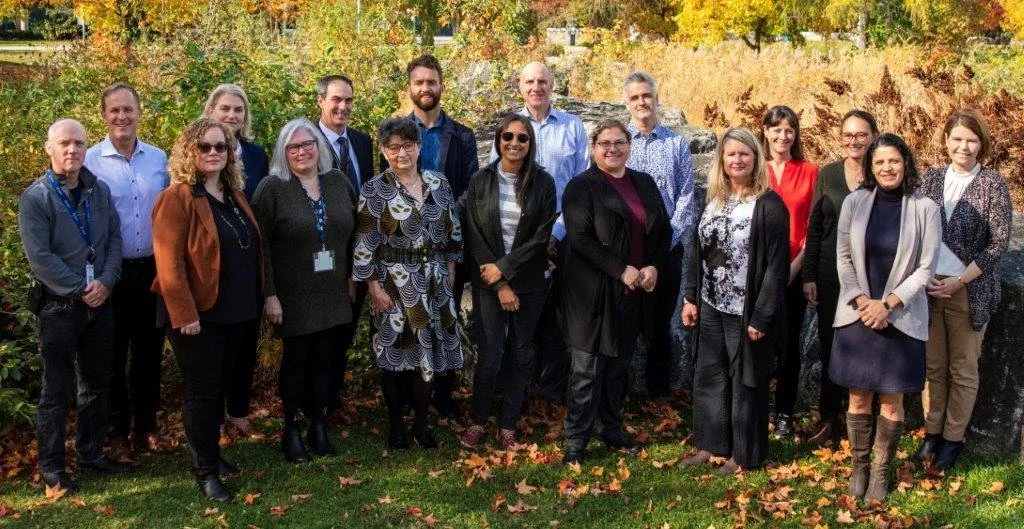

CCVO Timeline: Celebrating 20 Years
Prior to 2012_______________
In 2010, a Term of Reference was established.
A joint Council of Chief Medical Officers of Health - Council of Chief Veterinary Officers meeting in October 2010 established a Methicillin-resistant Staphylococcus aureus task group to provide guidance to health professionals on minimizing the human health risks of Methicillin-resistant Staphylococcus aureus associated with the human-animal interface.
In 2011, provincial and territorial Chief Veterinary Officers and Council of Chief Medical Officers of Health joined together in a meeting to discuss updates regarding Climate Change, Lyme Disease, National Farmed Animal Health and Welfare Council, and Zoonotic influenza and pandemic preparedness.
An Antimicrobial Resistance discussion also took place, recommending national actions to reduce Antimicrobial Resistance. These actions included limits to own-use imports and encouraging provinces to collect more information of Over-the-Counter sales/animal Antimicrobial Use use. These actions work to balance responses to Antimicrobial Resistance.
2013____________________
2013 saw the continued development of several pressing issues identified by the Council of Chief Veterinary Officers, including:
Completion of a framework for Canada’s national animal health surveillance system, as requested of the Council of Chief Veterinary Officers by the Federal-Provincial-Territorial Regulatory Assistant Deputy Ministers.
Implementation of an Antimicrobial Use surveillance working group, whose goal was to evaluate Antimicrobial Use data sources and surveillance in Canada.
Transition of rabies control programs from federal to provincial/territorial control.
Participation in identifying options for Canada’s next captive cervid chronic wasting disease control program, at the request of the Minister of Agriculture and Agri-Food. Development of a non-stun slaughter working group at the request from the FPT deputy ministers table, tasked with developing a slaughter without stunning standard.
The Council of Chief Veterinary Officers recognized porcine epidemic diarrhea as an emerging threat to Canada and provided advice and feedback towards the Canadian Swine Health Board’s Porcine Epidemic Diarrhea national response template. A Porcine Epidemic Diarrhea communications plan was prepared where Chief Veterinary Officers are to share their Porcine Epidemic Diarrhea plans through the Council of Chief Veterinary Officers secretariat and the Porcine Epidemic Diarrhea plans are to be posted on the Agri-forum; the first attempt at a shared document site.
The joint Council of Chief Veterinary Officers - Council of Chief Medical Officers of Health focused on putting One Health into action, discussion of emerging best practices for antimicrobial stewardship and use as well as the importance of vaccines and human and animal health.
2015____________________
The Council of Chief Veterinary Officers provided guidance regarding animal ownership after having received contact from individuals with potential Ebola Virus exposure in January. Guidance for managing companion animals that have been exposed to a human with Ebola Virus disease was also developed.
The Council of Chief Veterinary Officers performed an evaluation of a prescription use only policy for Veterinary Antimicrobials in April.
On May 21, the Council of Chief Veterinary Officers approved recommendation of the Council of Chief Veterinary Officers Subcommittee for the management of potential domestic animal exposures to rabies. Management of Potential Domestic Animal Exposures to Rabies (2015).
During 2015, the Guiding Principles for Animal Welfare document was finalized and approved. This document compiled collective opinions and understandings of the Council of Chief Veterinary Officers in an attempt to provide consistency in decision-making and discussion regarding animal welfare across the country.
2017____________________
The Office International des Epizooties performed a Performance of Veterinary Services evaluation of Canada. The Council of Chief Veterinary Officers was significantly engaged throughout the process to support completion of the report and evaluation of the findings.
The 2017 annual meeting focused on next steps following the release of the Plant and Animal Health Strategy | Stratégie sur la santé des animaux (animalhealthcanada.ca), with Chief Veterinary Officers discussing how a proactive, preventative approach could be prioritized and what infrastructure was required nationally to implement this approach in addition to exploration of how the Council of Chief Veterinary Officers, traceability and industry could remain linked through National Farmed Animal Health and Welfare Council for delivery of the Plant and Animal Health Strategy.
2019____________________
During 2019, the Council of Chief Veterinary Officers undertook a major facilitated strategic planning session as well as a revision and update of the Terms of Reference and workplan to optimize and refine the scope and mandate of the Council of Chief Veterinary Officers, as well as to identify gaps which the Council of Chief Veterinary Officers wished to tackle over the next three-year period.
African Swine Fever preparedness activities in Canada began to ramp up significantly, with Council of Chief Veterinary Officers members providing significant leadership, along with the Canadian Food Inspection Agency, the National Farmed Animal Health and Welfare Council and industry associations to implement a coordinated, national approach to emergency preparedness and response.
2021____________________
African Swine Fever planning continued to be a significant focus for the Council of Chief Veterinary Officers, including discussions on wild pigs, assessing available resources to support disease response and joint communications.
The Council of Chief Veterinary Officers conducted an exercise in 2021 to determine the key priorities of the Council of Chief Veterinary Officers for the future. These top priorities included African swine fever and zoonotic disease surveillance as well as the changing social license regarding animal use. These outcomes were used to guide the focus of the Council of Chief Veterinary Officers into 2021.
The first detection of highly pathogenic avian influenza occurred at the end of 2021. Highly Pathogenic Avian Influenza rapidly became a top priority for the Council of Chief Veterinary Officers, beginning in 2021 with information sharing and maintaining a focus on the global situation.
2023____________________
Highly Pathogenic Avian Influenza in poultry remained a significant focus for the Council of Chief Veterinary Officers through 2023, supporting ongoing conversations and policy development to address lessons learned during 2022.
Recognizing how much had changed with chronic wasting disease in Canada, the Council of Chief Veterinary Officers chronic wasting disease working group determined that there was a need to reinvigorate efforts in updating the 2011 Chronic Wasting Disease National Strategy. The group utilized connections through Results Driven Agriculture Research to assess how this need could be addressed. Efforts to move ahead on this file continued into 2024.
Collaboration with Animal Health Canada was a critical focus for the Council of Chief Veterinary Officers during 2023. The Council of Chief Veterinary Officers has long recognized the need for a collaborative approach to farmed animal health and welfare across the country and the importance of shared decision-making to ensure that outcomes consider all perspectives. The Council of Chief Veterinary Officers remains integrated into Animal Health Canada’s structure, with representation on many boards and committees.
After several years gap due to conflicting priorities and workload, the Council of Chief Veterinary Officers and Council of Chief Medical Officers of Health reconnected in 2023, discussing areas of shared interest, including including highly pathogenic avian influenza, chronic wasting disease, rabies and raw pet food.
2012____________________
The Council of Chief Veterinary Officers 2012 workplan prioritized information sharing and relationship building with the Council of Chief Medical Officers of Health, Canadian veterinary education institutions and with the Canadian Veterinary Medical Association.
The Council of Chief Veterinary Officers also focused their efforts around supporting implementation of the National Farmed Animal Health and Welfare Strategy and improving Federal-Provincial-Territorial capacity to prevent, detect and respond to animal health risks in a coordinated fashion, particularly through support for the Canadian Animal Health Surveillance Network, traceability systems and addressing foot and mouth disease preparedness.
The Council of Chief Veterinary Officers faced some challenging conversations during 2012 with respect to national disease monitoring and control programs. Following the release of the Deficit Reduction Action Plan put forward by government in April 2012, anthrax, anaplasmosis, rabies and chronic wasting disease were all identified as programs where the federal role would be reduced or eliminated. The Council of Chief Veterinary Officers provided significant leadership through a collaborative approach with the Council of Chief Medical Officers of Health to explore how to address the changes in responsibilities and identify the right path forward to ensure ongoing protection of animal and human health. The Council of Chief Veterinary Officers played a critical role during these ongoing discussions to utilize pan-Canadian expertise in developing the right path forward.
Following a discussion on provincial mandates and authority, it was agreed that the Council of Chief Veterinary Officers needed to become more involved in the area of animal welfare and the Council of Chief Veterinary Officers began developing a document of guiding principles of animal welfare.
In October 2012, the Council of Chief Veterinary Officers and Council of Chief Medical Officers of Health held a joint tabletop exercise in Quebec focused on exploring coordination and communications relating to a human-animal health scenario. Participants worked through a scenario involving urban racoons impacting human and animal health and explored coordination between animal health, wildlife and human health, the roles of provincial public health and Chief Veterinary Officers as well as additional partners.
2014____________________
The emerging threat of porcine epidemic disease virus and swine delta coronavirus was a focus for the Council of Chief Veterinary Officers and resulted in collaborative discussions on risk mitigation, potential policy amendments and roles for each province and territory.
The Council of Chief Veterinary Officers continued to advocate for the implementation of national surveillance through the National Farmed Animal Health and Welfare Council, promoting national leadership and identifying sustainable funding opportunities.
Animal welfare remained a priority for the Council of Chief Veterinary Officers through the development of a Guiding Principles for Animal Welfare document, the intent of which was to provide leadership on animal welfare and assurance to the public on oversight by government.
2016____________________
A position statement on Canine importation was signed by some Chief Veterinary Officers and a report of the Canadian National Canine Importation working group posted on June 9. Report of the Canadian National Canine Importation Working Group (2016)
The Council of Chief Veterinary Officers antimicrobial surveillance working group prepared a report on Non-Human Antimicrobial Use Surveillance in Canada: Surveillance Objectives and Options and gap analysis findings. Non-Human Antimicrobial Use Surveillance in Canada (2016)
Also published was a review of international non-human Antimicrobial Use surveillance programs compared to Canada. This work concluded that non-human Antimicrobial Use surveillance in Canada required improvement and outlined methods to be explored in order to address these shortcomings.
The Council of Chief Veterinary Officers continued to participate in the development of the Plant and Animal Health Strategy | Stratégie sur la santé des animaux (animalhealthcanada.ca).
2018____________________
The emergence of African swine fever spreading globally was an issue of significant importance to the Council of Chief Veterinary Officers, with the group actively engaged on monitoring the spread of disease internationally, identifying risks to Canada and assessing current prevention and response capacity. The Council of Chief Veterinary Officers understood the need to establish working groups to assess capacity and identify current options for emergency management, including identification of gaps, determining how the country would coordinate its response, and which resources would be necessary.
The Council of Chief Veterinary Officers developed a Chronic Wasting Disease White Paper through 2018, at the request of the Federal-Provincial-Territorial Regulatory Assistant Deputy Ministers of Agriculture. The Federal-Provincial-Territorial Regulatory Assistant Deputy Ministers requested this white paper to outline alternative options for Chronic Wasting Disease control in response to a joint letter sent by the Council of Chief Veterinary Officers in 2017, expressing significant concerns about Canadian Food Inspection Agency’s proposed changes to their CWD control program. New Canadian Food Inspection Agency’s Chronic Wasting Disease response policy also came into effect April 1, 2018. Chronic Wasting Disease: Alternative Disease Control Options (2018)
The Standards for Optimizing Animal Welfare Outcomes during Slaughter without Stunning document was completed in September 2018. This standard provided a science-based approach to improve animal welfare based on best practices that should apply to all slaughter establishments.
The national Antimicrobial Resistance Framework was implemented in 2018, providing a policy foundation to guide and align collective actions in tackling Antimicrobial Resistance in Canada. The Council of Chief Veterinary Officers provided ongoing feedback on the impacts of this framework on the agricultural sector in Canada and assessing opportunities for implementation.
2020____________________
During the COVID-19 pandemic, Chief Veterinary Officer members were heavily engaged in monitoring the emerging pandemic, assessing risks to animals and promoting a One Health approach, within their own jurisdictions and in collaboration across the country.
The Council of Chief Veterinary Officers also created a number of position statement in 2020:
The Restocking of premises with cervids position statement was released in July 2020 and outlined the Council of Chief Veterinary Officers’ recommendations pertaining to management of cervid farms with previous cases of Chronic Wasting Disease..
The Council of Chief Veterinary Officers released a position statement outlining the Impacts to Livestock and Poultry associated with Unauthorized Entry to Agricultural Premises. This document was crafted in response to recent incidents of protest actions taking place at Canadian swine and poultry operations.
The COVID-19 testing of animals position statement was crafted in response to the emerging pandemic and the resulting draw on resources and testing capacity in Canada. This statement provided guidance and consistency of approach between provinces and territories with respect to testing for COVID-19 in animals.
2022____________________
2022 saw an unprecedented number of highly pathogenic avian influenza detections in poultry in Canada, with outbreaks occurring more rapidly than anticipated. The Council of Chief Veterinary Officers remained fully engaged with provincial, territorial, federal and industry partners throughout the outbreaks, using the collective knowledge, advice and perspectives of the Council of Chief Veterinary Officers to address several challenges as they arose, including:
Equipment and human resource capacity
Policy implementation
Communications materials
Use of provincial/territorial legislative tools
While Highly Pathogenic Avian Influenza was a top priority for the Council of Chief Veterinary Officers, other important priorities included:
Development of a Rabies working group to assess current rabies control programs and focus on exploring mechanisms to ensure equitable access to rabies vaccines.
Collating jurisdictional efforts to address the veterinary workforce shortage.
Supporting exploration of a foot and mouth disease vaccine bank.
2024____________________
In April 2024, the Council of Chief Veterinary Officers held a strategic planning session in New Brunswick. Chief Veterinary Officers spent two days mapping out the role of the Council of Chief Veterinary Officers, updating the mandate and ensuring the strategic plan set specific, measurable, achievable, relevant and timebound goals. The outcome of this work was a more clearly redefined terms of reference and strategic plan to guide the work of this group through the next three years.
Highly Pathogenic Avian Influenza remained a significant area of focus for the Council of Chief Veterinary Officers,, not only in poultry but also in dairy cattle. With the emergence of H5N1 in dairy cattle in the United States, the Council of Chief Veterinary Officers spent considerable time dedicated to assessing scientific evidence, participating in discussions across jurisdictions, debating appropriate policies for Canada and defining roles and responsibilities.
Foot and Mouth Disease was an increased area of focus for the Council of Chief Veterinary Officers in 2024 and included the completion of a gap analysis and prioritization of Foot and Mouth Disease-related preparedness activities and infrastructure as well as participation in Animal Health Canada’s Foot and Mouth Disease working group.
The Council of Chief Medical Officers of Health and Council of Chief Veterinary Officers struck a federal-provincial-territorial senior leaders committee, which met regularly to discuss the human and animal health impacts of Highly Pathogenic Avian Influenza in dairy cattle. This group will continue regular conversations on this issue as they assess shared policy recommendations and enhance One Health collaboration in all Canadian jurisdictions.
Photo Gallery





















